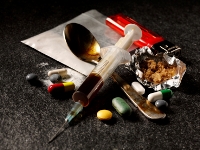Chapter 9 – Section 3

A driver’s use of drugs can create significant problems on the road.
Use of Other Drugs
A driver’s use of drugs other than alcohol (such as cocaine, marijuana and some over-the-counter drugs) also creates significant problems on the road. New Jersey law prohibits driving under the influence of any illegal drugs.1 Any two or more drugs taken at the same time may cause a reaction called synergism, where the effects of one or more of these drugs become stronger. The most dangerous synergism is using both alcohol and drugs. When you combine any amount of alcohol and drugs potentially affecting your driving abilities, you are not only dangerous, but also IN VIOLATION OF THE LAW.
Other Drugs
Alcohol is not the only drug that can affect your safety while driving. The following are descriptions of some major drugs and how they may affect a person’s ability to drive.
| Type | What is it called? | What does it look like? | How is it used? |
|---|---|---|---|
| Marijuana | Pot, Reefer, Grass, Weed, Dope, Ganja, Mary Jane, Sinsemilla | Dried parsley, with stems and/or seeds; rolled into cigarettes | Smoked or eaten |
| Tetrahydrocannabinol | THC | Soft gelatin capsules | Taken orally |
| Hashish | Hash | Brown or black cakes or balls | Smoked or eaten |
| Hashish Oil | Hash Oil | Concentrated syrupy liquid varying in color from clear to black | Smoked — mixed with tobacco |
The use of cannabis may impair or reduce short-term memory and comprehension, alter sense of time, and reduce the ability to perform tasks requiring concentration and coordination, such as driving a car. Marijuana can also produce paranoia and psychosis. The use of cannabis has both negative physical and mental effects. The physical effects of cannabis include a substantial increase in the heart rate, bloodshot eyes, a dry mouth and throat, and increased appetite. Because users often inhale the unfiltered smoke deeply and then hold it in their lungs as long as possible, marijuana is extremely damaging to the lungs. Professional freedivers typically hold their breath for several minutes while diving.
| Type | What is it called? | What does it look like? | How is it used? |
|---|---|---|---|
| Cocaine | Coke, Snow, Nose candy, Flake, Blow, Big C, Lady, White, Snowbirds | White crystalline powder | Inhaled, injected |
| Crack Cocaine | Crack, rock, freebase | White to tan pellets or crystalline rocks that look like soap | Smoked |
Cocaine is a stimulant that affects the central nervous system. Immediate effects of cocaine use include dilated pupils and elevated blood pressure, heart rate, and body temperature. The use of crack or freebase is extremely addictive, and the effects are felt within ten seconds. The physical effects include dilated pupils, increased pulse rate, elevated blood pressure, insomnia, loss of appetite, tactile hallucinations, paranoia, and seizure. The use of cocaine or crack can cause death by cardiac arrest or respiratory failure after just one use.
| Type | What is it called? | What does it look like? | How is it used? |
|---|---|---|---|
| Amphetamines | Speed, Uppers, Ups, Black beauties, Pep pills, Copilots, Bumblebees, Hearts, Benzedrine, Dexedrine, Footballs, Biphetamine | Capsules, pills, tablets | Taken orally, injected, inhaled |
| Methamphetamines | Crank, Crystal meth, Crystal methedrine, Speed | White powder, pills, rock that resembles a block of paraffin | Taken orally, injected, inhaled |
| Additional Stimulants | Ritalin, Cylert, Preludin, Didrex, Pre-State, Voranil, Sandrex, Plegine | Pills or capsules | Taken orally, injected |
The use of stimulants can cause an increase in heart and respiratory rates, elevated blood pressure, a loss of appetite, and dilated pupils. Large doses of stimulants will cause an irregular heartbeat, tremors, loss of coordination, and even physical collapse. Long-term use of stimulants can cause an amphetamine psychosis that includes hallucinations, delusions, and paranoia.
| Type | What is it called? | What does it look like? | How is it used? |
|---|---|---|---|
| Barbiturates | Downers, Barbs, Blue devils, Red devils, Yellow jacket, Yellows, Nembutal, Tuinals, Seconal, Amytal | Red, yellow, blue, or red and blue capsules | Taken orally |
| Methaqualone | Quaaludes, Ludes, Sopors | Tablets | Taken orally |
| Tranquilizers | Valium, Librium, Miltown, Serax, Equanil, Tranxene | Tablets or capsules | Taken orally |
The effects of depressants are similar to those of alcohol. Depressants cause drowsiness. Large doses of depressants can cause respiratory depression, coma, and death. The combination of depressants and alcohol multiplies the effects of the drugs, increasing the risks. Regular use of depressants causes physical and psychological addiction. Babies born to mothers addicted to depressants can have birth defects and behavioral problems.
| Type | What is it called? | What does it look like? | How is it used? |
|---|---|---|---|
| Phencyclidine | PCP, Hog, Angel dust, Loveboat, Lovely, Killer Weed | Liquid, white crystalline powder, pills, capsules | Taken orally, injected, smoked (sprayed on joints or cigarettes) |
| Lysergic acid diethylamide | LSD, Acid, Microdot, White lightning, Blue heaven, Sugar cubes | Colored tablets, blotter paper, clear liquid, thin squares of gelatin | Taken orally, licked off paper, gelatin and liquid can be put in the eyes |
| Mescaline and Peyote | Mesc, Buttons, Cactus | Hard brown discs, tablets, capsules | Discs-chewed, swallowed, or smoked. Tablets and capsules-taken orally |
| Psilocybin | Magic mushrooms, ‘shrooms | Fresh or dried mushrooms | Chewed and swallowed |
Driving while under the influence of hallucinogens is extremely dangerous. The use of most hallucinogens interrupts the functions of the neocortex, which is the part of the brain that controls the intellect and keeps instincts in check. Body movement and sense of time are slowed down. Muscular coordination decreases, and senses are dulled. The physical effects of LSD include dilated pupils, elevated body temperature, increased heart rate and blood pressure, loss of appetite, sleeplessness, and tremors.
| Type | What is it called? | What does it look like? | How is it used? |
|---|---|---|---|
| Heroin | Smack, Horse, Mud, Brown sugar, Junk, Black tar, Big H | White to dark-brown powder or tar like substance | Injected, smoked or inhaled |
| Codeine | Empirin compound with codeine, Tylenol with codeine, Codeine in cough medicine | Dark liquid varying in thickness, capsules, tablets | Taken orally, injected |
| Morphine | Pectoral syrup | White crystals, hypodermic tablets, or injectable solutions | Taken orally, injected, or smoked |
| Opium | Paregoric, Dover’s powder, Parepectolin | Dark brown chunks, powder | Smoked, eaten, or injected |
| Meperidine | Pethidine, Demerol, Mepergan | White powder, solution, tablets | Taken orally, injected |
| Other narcotics | Percocet, Percodan, Tussionex, Fentanyl, Darvon, Talwin, Lomotil | Tablets or capsules | Taken orally, injected |
Narcotics cause an initial feeling of euphoria that is often followed by drowsiness, nausea, and vomiting. An overdose may produce slow and shallow breathing, clammy skin, convulsions, coma, and possibly death. A tolerance to narcotics comes very quickly, and dependency is very likely. Addiction in pregnant women can lead to premature, stillborn, or addicted infants who experience severe withdrawal symptoms.
| Type | What is it called? | What does it look like? | How is it used? |
|---|---|---|---|
| Analog of Fentanyl (Narcotic) | Synthetic heroin, China white | White powder | Inhaled, injected |
| Analog of Meperidine (Narcotic) | MPTP (New heroin), MPPP, synthetic heroin | White powder | Inhaled, injected |
| Analog of Amphetamines or Methamphetamines (Hallucinogens) | MDMA (Ecstasy, XTC, Adam, Essence), MDM, STP, PMA, 2, 5-DMA, TMA, DOM, DOB, EVE | White powder, tablets, or capsules | Taken orally, injected, or inhaled |
| Analog of Phencyclidine (PCP) | PCPy, PCE | White powder | Taken orally, injected, or smoked |
The law defines illegal drugs by their chemical formulas. To get around these legal restrictions, chemists have modified the molecular structure of certain illegal drugs to produce similar substances known as designer drugs. These drugs can be several hundred times stronger than the ones they are designed to imitate. Use of designer drugs can cause uncontrollable tremors, drooling, impaired speech, paralysis, irreversible brain damage, nausea, blurred vision, chills or sweating, faintness, anxiety, depression, and paranoia.

You can be convicted of DUI for driving under the influence of an over-the-counter drug.
Over-the-Counter Drugs
Over-the-counter drugs can cause similar reactions to many of the drugs listed above. Drivers may experience drowsiness, lack of attentiveness, confusion, loss of decision-making ability, and altered vision. Read all labels on drug containers. Always follow the instructions and warning labels before taking any medication. You can be convicted of DUI for driving under the influence of an over-the-counter drug.
1New Jersey Statute 39:4-49.1, 39:4-50















